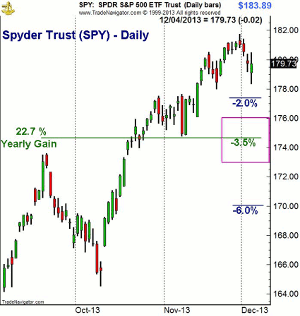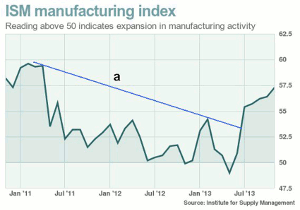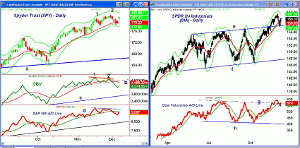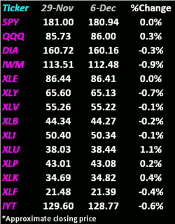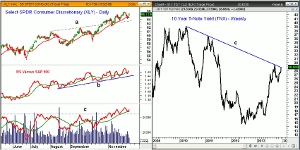At over 4-1/2 years old, the current bull market is already one of the longest since the Great Depression, and MoneyShow's Tom Aspray examines the technical evidence for signs of how much higher it can go before the end of the year.
Many who are not invested in stocks have been fighting the urge to buy stocks as the market moves higher and higher. The evidence continues to suggest that the public is still not very invested in the stock market. As rates continue to edge higher, many are now also facing losses in their bond portfolios and their year-end statements may provide a shock.
All of the major averages, except the Nasdaq 100, made their highs at the end of November before correcting last week. This was consistent with the deterioration in the technical studies that was especially evident after last Monday's close. It will take more than Friday's sharp rally on the jobs report to reverse the signs of deterioration.
Things are much different than a year ago, as in December of 2012, the NYSE Advance/Decline line was leading prices higher, so I felt fairly confident just before Christmas that 2013 would Be Another Double-Digit Year. With the Spyder Trust (SPY) currently up 27.50%, the question now becomes will stocks hold these gains until the end of the year or will they close even higher?
Let's look at the evidence. First of all, December is a good month for stocks with an average return since 1950 of 1.6%. This would give an end-of-the-year target of $183.89 (see chart) for the SPY.
One can get an even more bullish forecast by just looking at those years since 1990 when the S&P 500 was already up over 20% or more at the end of November. This has only occurred seven times in the past 22 years and the average December gain was 3.5%. This would give a year-end target for the SPY of $187.33. The best year was 1991 when the S&P was up 11.1%.
Unlike last December, the key technical studies are now acting weaker, not stronger, than prices so I cannot be nearly that bullish going into the end of the year. If you look at the years since 1950 when the S&P 500 did close lower in December, the average decline was just over 2%. If the SPY were to close 2% lower this month, then the SPY should settle 2013 at around $177.38.
From the current technical readings, as well as the pivot point and Fibonacci analysis, it is possible that the SPY could decline 3.5% in December, which would give a target for the SPY at $174.70. On the chart, I have drawn a year-end target zone that ranges from $173-$176 (box on chart) with a mid-point of 3.5% or 4174.68.
A correction should give those not in the market an opportunity to buy. Hopefully many of you started a dollar cost averaging program as suggested in August and have been participating in the market's gains.
I see no signs of a major top for the stock market, though it is not clear yet whether we will see a brief setback or a more extended correction. After a correction, the sentiment for stocks should be much less bullish, which will create an environment that will allow the market to move even higher. This week's action should give us additional clues as to what type of correction is the most likely.
If you are fully invested, raising some cash would be a good idea, and you should also sell or reduce the position in those stocks that are not performing. This is the strategy that I suggested last week in the review of the Charts in Play portfolio. There are always exceptions but those stocks that have not rallied with the market since October are likely to be the most vulnerable when the market corrects.
NEXT PAGE: What to Watch
|pagebreak|As the stock market declined early in the week, the news on the economy continued to improve. The ISM Manufacturing Index jumped nicely on Monday to 57.3 and New Home Sales for October jumped 25.4%. Both were much better than economists expected. The move through the downtrend from the 2011 highs (line a) in the ISM Manufacturing Index is a positive sign.
The news was also good from a global perspective as according to Markit.com's Global PMIT it is "tracking a pace of global growth approaching 3% per annum." Last Thursday's upward revision of the 3rd quarter US GDP to 3.6% was also a welcome surprise. The strong monthly jobs report should also help boost consumer confidence.
I expect the economy to improve further in 2014, which will allow the Fed to eventually "taper" but I am not expecting such a change until after Janet Yellen takes over. It has been my view since the last wave of double-dip recession forecasts in September of 2011 that the underlying economy was stronger than most believed and that it was bullish for stocks.
The news out of the Eurozone also was better than expected as Germany continues to do quite well, with its construction industry likely to grow sharply in the 4th quarter. Its commercial property is apparently now quite attractive to long-term Asian investors who have avoided these markets in the past.
The outlook for the UK economy has also shown significant improvement as its construction industry is even stronger than that of Germany. Other sectors are also showing nice growth rates with unemployment finally coming down. Therefore, I found this picture from the Business Insider to be a good example of how removed most politicians are from their constituents.
It was taken as Prime Minister Cameron was giving a speech where he argued for a policy of permanent austerity. The lavish surroundings highlighted on the picture do not pass the austerity smell test.
This week, we have a fairly light economic schedule as many are already looking towards the FOMC meeting that starts on December 17. Quite a few of the Fed regional presidents are scheduled to speak on Monday followed on Wednesday by the Treasury Budget.
On Thursday we get jobless claims, which have been declining nicely along with the latest reading on Retail Sales. The Producer Price Index will be released on Friday.
What to Watch
Only the PowerShares QQQ Trust (QQQ) made a new high last week as most of the major averages are still well below the late-November highs. As detailed, some of the daily technical studies have diverged from prices and suggest a top is being formed.
The weekly volume analysis is positive and does not show signs of a significant top. If the remaining averages, like the Dow and S&P 500, make new highs this week, the technical studies will need to be watched closely to see if divergences are formed. A reversal to the downside would be negative.
In my view, the next two-four weeks are likely to be treacherous as a drop below last week's lows will generate stronger sell signals. Basis the number of S&P 500 stocks above their 50-day MA, the market is neutral as it is very close to its mean at 62. It could form another lower peak on a rally this week.
The AAII sentiment improved slightly last week as the bullish percentage is at 42.6%, down from 47.3% the prior week. The bearish % is at 27.5%, which is well above the low reading of 17.5% on October 24. The number of bullish financial newsletter writers has risen even further to 57.1%, with just 14.3% now bearish.
NEXT PAGE: Stocks
|pagebreak|The weekly chart of the NYSE Composite shows the doji three weeks ago, and while the doji low has been broken during the past two weeks, the NYSE has not closed below it. This is necessary before a weekly low close doji sell signal could be triggered.
There is first weekly support now at 9900-9990 with the weekly uptrend, line b, now at 9742. The NYSE hit the monthly projected support at 9985 last week and the quarterly pivot is at 9558.
The weekly NYSE Advance/Decline numerically made a slight new high two weeks ago even though it does not look like it on the chart. The WMA and support at line b are being tested. If the market internals are negative this week, the support could be broken, which is consistent with a further decline.
The daily A/D line (not shown) dropped below the prior two lows last week but closed the week above these lows but is still below its WMA. The McClellan oscillator dropped to -133 Thursday before it also rebounded. A close back above the +50 level would be a positive sign.
S&P 500
The Spyder Trust (SPY) came close to its daily starc- band on Wednesday but closed well above the week's lows. The next resistance is at the all-time high of $181.75 with the daily starc+ band at $182.70. The quarterly R3 resistance and the monthly projected resistance are in the $186-$187 area.
The 20-day EMA at $179.20 now represents first support as it was briefly broken last week. There is more important support now at $178-$178.35, which if broken, should signal a move to the monthly projected support at $176.59.
The daily on-balance volume (OBV) dropped below its WMA and support at line b last week. The OBV also formed a negative divergence at point 2, which is consistent with a top formation. It needs to rise sharply above its declining WMA and prior peak to turn positive.
The S&P 500 A/D line shows a similar pattern as it has formed lower highs (line d) and has just rallied back to its WMA. The A/D line is well above the major support.
Dow Industrials
The SPDR Dow Industrials (DIA) made a convincing new high at $161.58 at the end of November but at last week's low was 2.3% below the highs. It was able to close the weekly back above the monthly pivot at $159.06.
The correction retested the breakout level, line e, which is normally a very positive sign. The daily starc+ band is at $161.54 with the weekly at $164.75.
The Dow Industrials' A/D line did finally confirm prices in November by overcoming the resistance at line g. It closed the week above this level as well as its WMA.
Nasdaq-100
The PowerShares QQQ Trust (QQQ) closed at new rally highs Friday as the Dec. 2 high at $85.96 was exceeded. The daily starc+ band is now at $86.99 with the weekly at $87.50. The quarterly R3 resistance is at $88.09.
There is first key support at last week's low of $84.78 with a more important band of support between $81.39 and $84.
The OBV did make a new high in late November and has turned up from its WMA but has not yet made a new high. The OBV has first good support at line b.
The Nasdaq 100 A/D line shows a clear pattern of higher highs, line c, and held above its WMA during last week's correction. The A/D line has longer-term support at line d.
Russell 2000
The iShares Russell 2000 Index (IWM) had a wide range last Wednesday and closed right on the monthly pivot of $111.60. It is still well below the high from November 29 at $114.16.
The quarterly R2 is at $114.89 with the daily starc+ band at $114.83. The upper boundary of the trading channel (lines e and f) is now just above $115.
The daily OBV formed a significant negative divergence at the November highs, line g. The OBV has edged above its WMA with key resistance now at the downtrend. There is more important OBV support at line h.
The Russell 2000 A/D line does look stronger as it dropped down to support at line i before turning higher. It held its still rising WMA on the recent pullback
NEXT PAGE: Sector Focus, Commodities, and Tom's Outlook
|pagebreak|Sector Focus
The iShares Dow Jones Transportation (IYT) made a new high last Monday at $130.78 but closed the week down slightly. The low from last Wednesday at $126.60 is first support with monthly projected support at $125.76.
The daily OBV did not confirm the recent highs and the weekly also shows a slight negative divergence. There is more important support now at $123.62 and the early November low.
The sharp rally Friday helped to reverse the losses from early in the week but only 1/3 of the ETFs were able to close the week higher.
The defensive Select SPDR Utilities (XLU) was up 0.7% as it has been hurt lately by higher rates.
The next best gainers were technology-based as the Select SPDR Technology (XLK) and the PowerShares QQQ Trust (QQQ) were both up 0.5%. In Friday's column, I discussed whether Apple, Inc. (AAPL) would be the fuel to power the tech sector higher.
The technical outlook for the Select SPDR Health Care (XLV) was also discussed as several of its large holdings are starting to act more toppy. XLV closed the week pretty much unchanged.
The Select SPDR Consumer Discretionary (XLY) was one of the weakest, down 0.7%, but the daily chart stills looks positive as it held the 20-day EMA on the pullback. The quarterly R3 resistance and the next major target it at $67.
The relative performance still shows a solid uptrend, line b, and did confirm the recent highs. The OBV has also turned up from its rising WMA and is acting well.
Interest Rates
The yields on the 10 year T-note has been moving higher since the end of October as the market has been anticipating the Fed tapering. The weekly downtrend, line d, that connects the 2010 and 2011 highs is now being tested. The momentum studies are positive and do indicate that yields will move higher.
Crude Oil
Crude oil closed almost $5 per barrel higher last week suggesting that a low is now in place. The close was above the prior four-week highs. The weekly OBV is still below its WMA but the daily is positive. The energy stocks have held up well as crude oil prices have dropped, so it will be important that they start to move higher with crude.
Precious Metals
The Spyder Gold Trust (GLD) had little reaction to the jobs report but had a wild week. There appears to have been heavy short covering on Wednesday but the market was not able to hold its gains as GLD closed the week flat. The sentiment is very negative but there are no signs yet of a bottom.
The Week Ahead
I have been a bit more cautious since before Thanksgiving, and while the market could still have another upward explosion, it could come back down even faster. It has been a very good year for those who were bullish a year ago, and now is not the time to be reckless and take positions where the risk is too high.
As I noted last week, there are some groups like the retailers, which are acting overextended and may be vulnerable to profit-taking even if the retail numbers are strong this week.
If you have been watching stocks from the sidelines all year, don't buy now. I feel very confident that there will be a much better buying opportunity in the next few months. I hope that those of you who have large bond portfolios have shortened the maturity of your bonds as I recommended in May. If you did, your bonds will be better able to withstand higher rates.
Some buy candidate are likely to show up before the end of the year but they will have to pass a stricter criteria before I recommend them. They will need to have a risk of 3% and a potential reward of 15% or greater.
The most important action to take between now and year end is to closely review your portfolio when the markets are closed. This means taking some profits to raise cash and also be sure that your existing profits are protected by stops.
I will continue to adjust the holdings in the Charts in Play portfolio, so keep an eye on my Twitter feed as changes will appear there first.
Don't forget to read Tom's latest Trading Lesson, My Four Favorite Research Sites.

